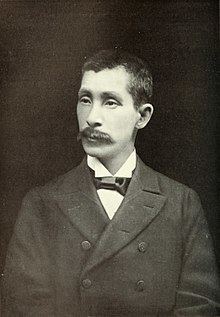Nationality Japan Role Statesman | Name Komura Jutaro | |
 | ||
Occupation Diplomat, Foreign Minister of Japan Education | ||
Marquis Komura Jutarō, GCB, GCMG, GCVO (小村 壽太郎, September 16, 1855 – November 25, 1911) was a statesman and diplomat in Meiji period Japan.
Contents
Biography

Komura was born to a lower-ranking samurai family in the service of the Obi Domain in Kyushu's Hyūga Province (present-day Nichinan, Miyazaki Prefecture). He attended the Daigaku Nankō (the predecessor of Tokyo Imperial University). In 1875, he was selected by the Ministry of Education as one of the first students to study abroad under a government scholarship. While at Harvard University, Komura shared lodgings with fellow Japanese student Kaneko Kentarō. In due course, Komura graduated from Harvard Law School in 1878.
Career of government service
In 1880, Komura joined the Ministry of Justice and after serving as a judge of the Supreme Court, in 1884 transferred to the Translation Bureau in the Ministry of Foreign Affairs.
In 1893, Komura was chargé d'affaires at the Japanese legation in Beijing, in Qing dynasty China. In this position, he conveyed to the Chinese government Japan's intention of dispatching troops to Korea under the provisions of the Treaty of Tientsin to subdue the Tonghak Rebellion – actions which led to the First Sino-Japanese War. During the war, Komura was appointed as civilian administrator for territories Japan had captured in Manchuria. He was also a key figure in the negotiations to end the war, culminating in the Treaty of Shimonoseki, which he helped draft.
Following the assassination of Queen Min of Korea, Komura was dispatched to replace Miura Gorō as Japanese minister to Korea. In his position as resident minister in Korea, he negotiated the Komura-Weber Memorandum in May 1896 with his Russian counterpart Karl Ivanovich Weber, allowing joint interference into Korean internal affairs by the Empire of Japan and the Empire of Russia.
Komura served as Vice Minister for Foreign Affairs until September 1898, when he was named ambassador to Washington, D.C..
In September 1901, Komura became Minister for Foreign Affairs under the first Katsura administration, and signed the Boxer Protocol on behalf of Japan. He was elevated into the kazoku peerage with the title of baron (danshaku) in 1902 and decorated with the 1st class of the Order of the Rising Sun. Later in 1902, Komura helped conclude the Anglo-Japanese Alliance in 1902. His tenure as Foreign Minister was marked with increasing tension between Japan and Russia over Korea and Manchuria, cumulating in the Russo-Japanese War of 1904–1905.
The war was ended with Komura's signature on behalf of the Japanese government of the Treaty of Portsmouth, which was highly unpopular in Japan, leading to the Hibiya incendiary incident Komura also met with E. H. Harriman, the American railway magnate, to propose a joint venture between his conglomerate and Japan towards the development of the South Manchuria Railway. On his return to Japan, he found that the agreement was opposed by the genrō, and was not implemented.
Komura also met with Chinese representatives in Beijing, signing the Peking Treaty of December 1905, which transferred former Russian rights in southern Manchuria to Japan.
For these services, Komura was awarded the Order of the Paulownia Flowers in 1906, and was appointed to become a member of the Privy Council.
From June 1906 to August 1908, Komura served as ambassador to Great Britain, during which time he was made a K.C.B. by King Edward VII and made a member of the Royal Victorian Order. On his return to Tokyo he resumed the post of Foreign Minister in the 2nd Katsura administration, signing the Root–Takahira Agreement with the United States. His peerage title was also elevated to that of Count ("hakushaku") in 1907.
Komura also played a key role in the Japan-Korea Annexation Treaty in 1910, and in concluding various international agreements in 1911 to restore Japan's tariff autonomy. He was elevated to the title of Marquis ("koshaku") on April 21, 1911.
Suffering from tuberculosis in his final years, Komura moved to the seaside resort of Hayama in Kanagawa Prefecture; however, he died of the disease on November 26, 1911. His grave is at Aoyama Cemetery in Tokyo.
In popular culture
Per Ryōtarō Shiba in his semi-historical work Saka no Ue no Kumo, Komura inherited massive debts from his father, which he had difficulty with repayment. As a result, he wore the same frayed frock coat for years, regardless of season or occasion. This, combined with his short statue and large mustache, led to the derisive nickname of "the rat minister" in the diplomatic community in his early career. In the Japanese Taiga drama adaptation of Shiba’s work, the role of Komura is played by actor Naoto Takenaka.
Honors
From the article in the Japanese Wikipedia
